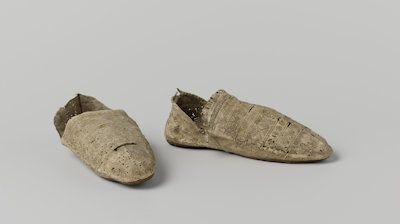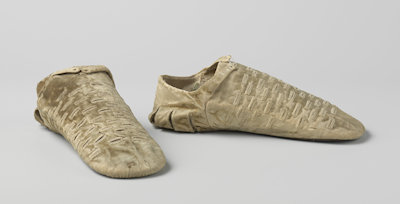Pumps

Thy pumps as white as was the milk,
While we have a fairly clear idea of what a pair of pump shoes are like in the 21st century, it is much less clear what 16th century people meant when they described shoes as ‘pumps’. The first recorded usage of the term only dates from the mid-16th century, appearing just a few decades before the Greensleeves ballad was published. By the 17th century the term pump came to describe a specific type of shoe, usually flat (in contrast to the high heels of the 17th century), flexible shoes for dancing. Yet before the 17th century a pump is a lot more vague, though usually describing a fashionable single-soled light-weight indoor shoe.
Janet Arnold describes pumps as "single soled low shoes which fitted the foot closely"[i]

Text from A Midsummer Night’s Dream
The pumps may well have been tied on with ribbons or laces. An account of the clothing of the Assyrians in The Fardle of Facions (1555) states that "Their shoes are not fastened on with lachettes, but lyke a poumpe close about the foote.” Shakespeare also mentions pumps tied with ribbons in A Midsummer Night’s Dream.
In the 1580s, like today, milk white shoes were a mark of status, showing your ability to keep an expensive item out of dirt and mud. They usually appear in 16th century texts with pantofles (overshoes), suggesting a particularly delicate or fine type of shoe. However, our Lady Greensleeves' lover has forgotten to give her overshoes to protect her pumps!
Eva Burnett will be making the pumps, taking inspiration from extant pairs in the Rijksmuseum. They will be single-soled turnshoes made with a fine white Italian leather and stamped with a decorative pattern.

Pair of shoes, c.1550-c.1574,
The Rijksmuseum, BK-NM-7419-A

Pair of shoes, c.1550-c.1574,
The Rijksmuseum, BK-NM-7420-A
[i] Janet Arnold, Queen Elizabeth’s Wardrobe Unlock’d (Leeds: Maney, 1988)

